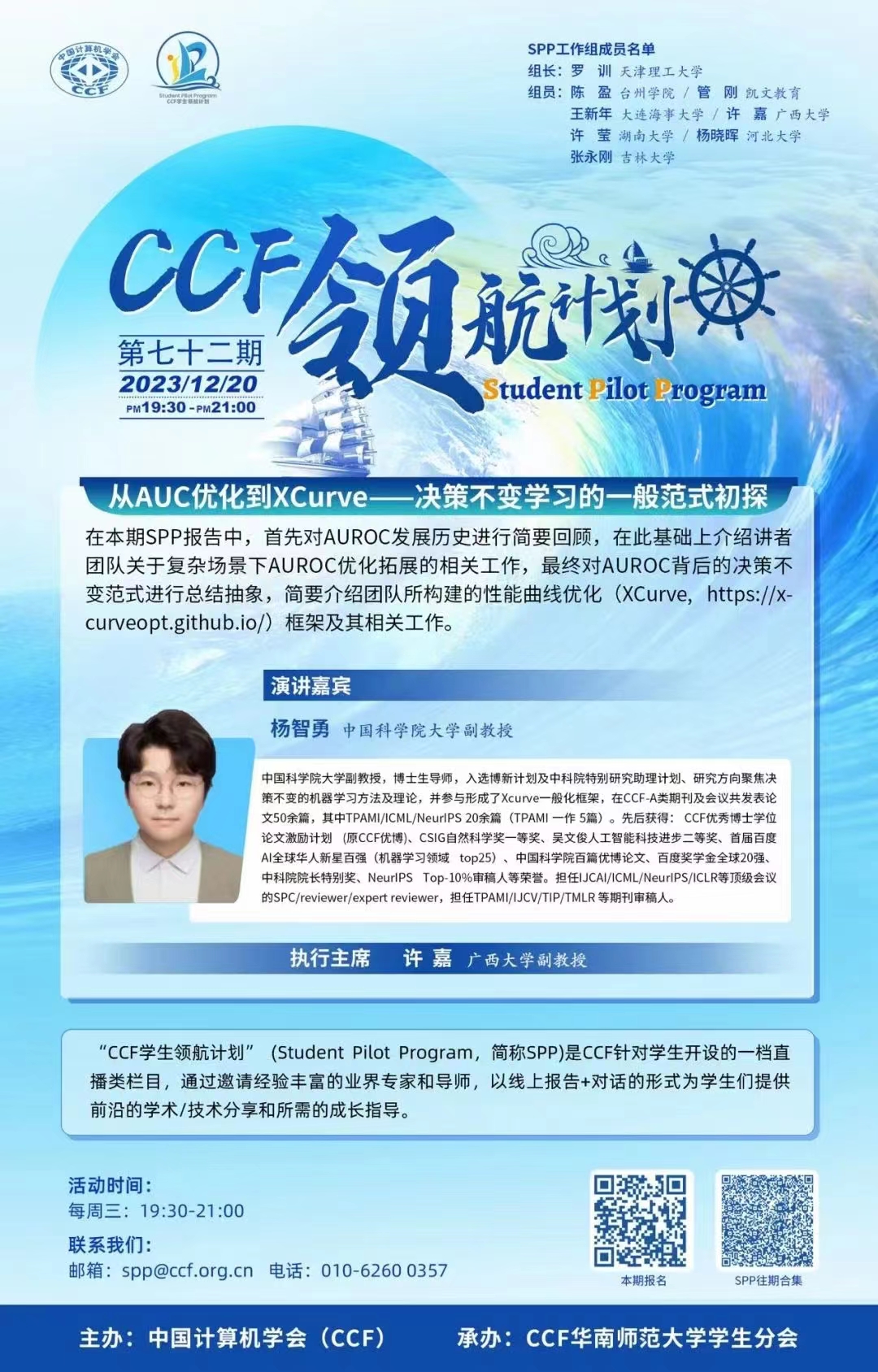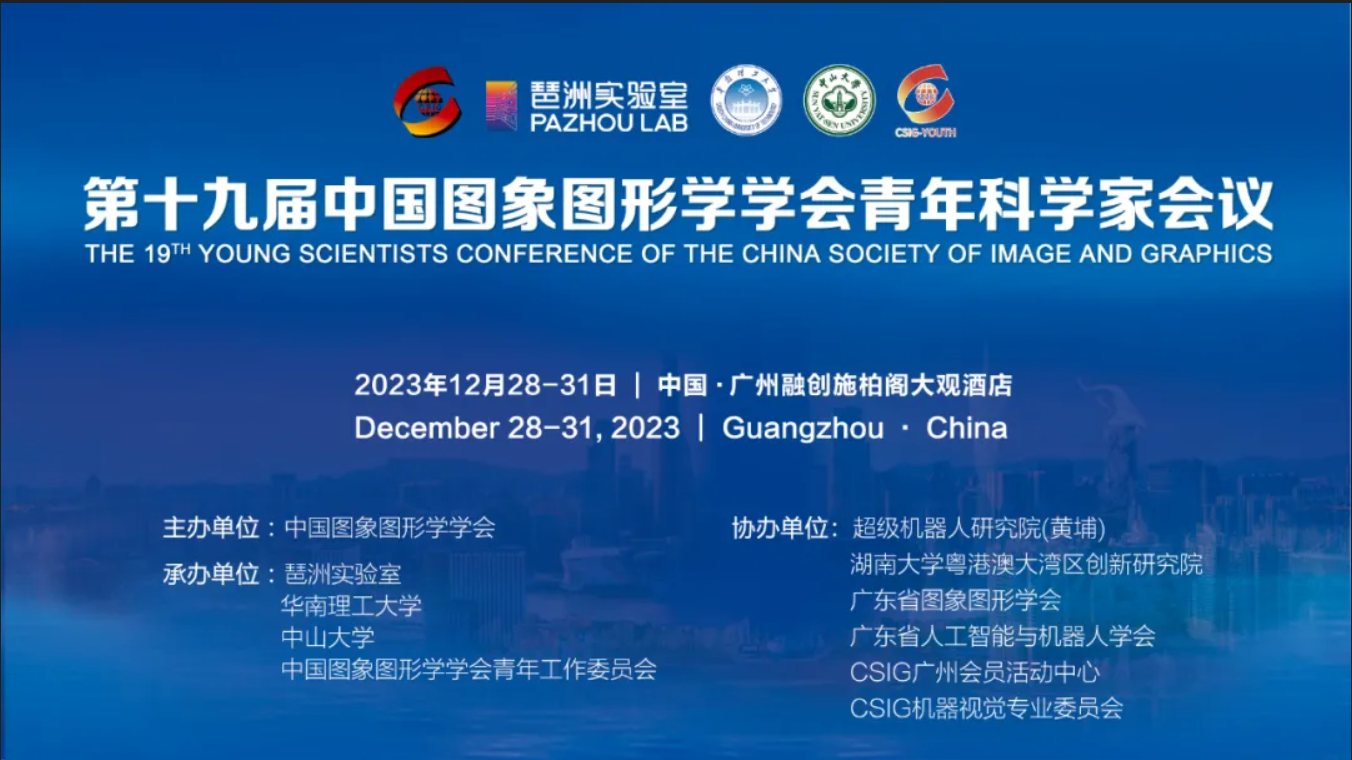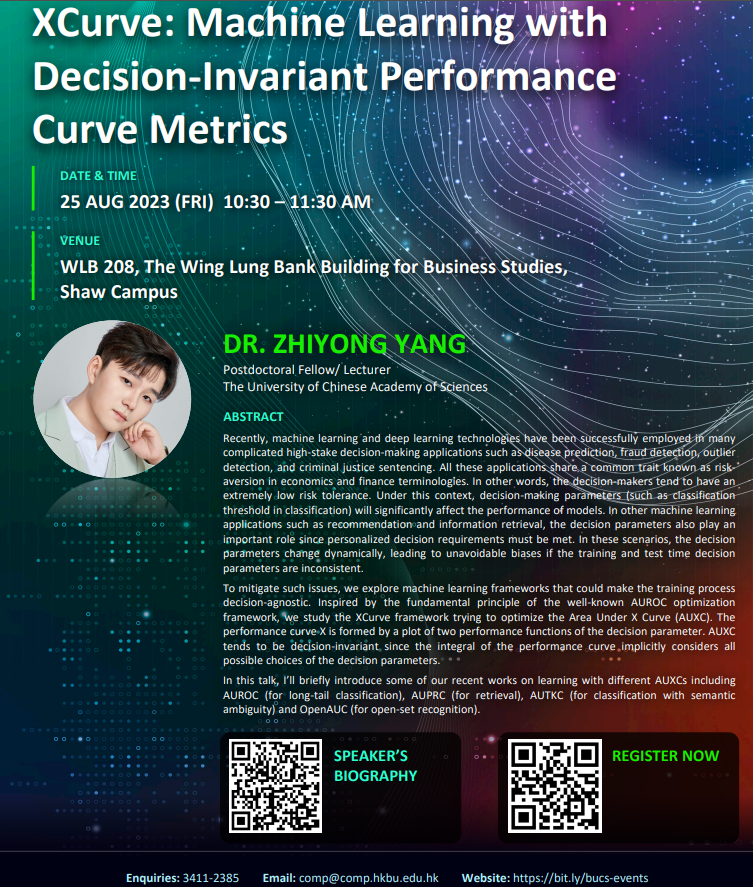Talks
- TechBeat

- Zhiyong Yang, Qianqian Xu, Shilong Bao, Yuan He, Xiaochun Cao and Qingming Huang. Optimizing Two-way Partial AUC with an End-to-end Framework. TPAMI, 2022.
- Huiyang Shao, Qianqian Xu, Zhiyong Yang, Shilong Bao, Qingming Huang. Asymptotically Unbiased Instance-wise Regularized Partial AUC Optimization: Theory and Algorithm. NeurIPS, 2022.
- HKBU

In this talk, I provided a brief introduction of AUROC as a decision-invariant metric, reviewed the history of AUROC and AUROC-oriented machine learning methods, and then presented some of our latest work on AUC-oriented learning with complicated scenarios (Partial AUROC Optimization, Adversarial Learning, and Recommendation):
- Zhiyong Yang, Qianqian Xu, Shilong Bao, Yuan He, Xiaochun Cao and Qingming Huang. Optimizing Two-way Partial AUC with an End-to-end Framework. TPAMI, 2022.
- Wenzheng Hou, Qianqian Xu, Zhiyong Yang, Shilong Bao, Yuan He and Qingming Huang. AdAUC: End-to-end Adversarial AUC Optimization Against Long-tail Problems. ICML2022
- Shilong Bao, Qianqian Xu, Zhiyong Yang, Xiaochun Cao and Qingming Huang. Rethinking Collaborative Metric Learning: Toward an Efficient Alternative without Negative Sampling. IEEE Transactions on Pattern Analysis and Machine Intelligence (T-PAMI), 2021.
- TechBeat

- Zhiyong Yang, Qianqian Xu, Shilong Bao, Yuan He, Xiaochun Cao and Qingming Huang. When All We Need is a Piece of the Pie: A Generic Framework for Optimizing Two-way Partial AUC. International Conference on Machine Learning (ICML), 11820–11829, 2021
- Zhiyong Yang, Qianqian Xu, Shilong Bao, Xiaochun Cao and Qingming Huang. Learning with Multiclass AUC: Theory and Algorithms. IEEE Transactions on Pattern Analysis and Machine Intelligence (TPAMI), 2021. (Early Access)
- AI TimeWhen All We Need is a Piece of the Pie: A Generic Framework for Optimizing Two-way Partial AUC, 2021
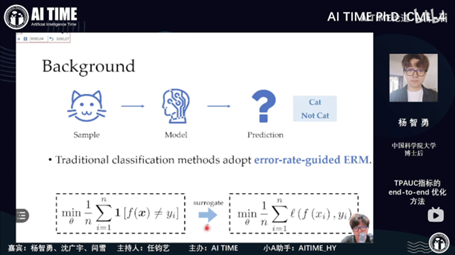
The Area Under the ROC Curve (AUC) is a crucial metric for machine learning, which evaluates the average performance over all possible True Positive Rates (TPRs) and False Positive Rates (FPRs). Based on the knowledge that a skillful classifier should simultaneously embrace a high TPR and a low FPR, we turn to study a more general variant called Two-way Partial AUC (TPAUC), where only the region with TPR ≥ α, FPR ≤ β is included in the area. Moreover, a recent work shows that the TPAUC is essentially inconsistent with the existing Partial AUC metrics where only the FPR range is restricted, opening a new problem to seek solutions to leverage high TPAUC. Motivated by this, we present the first trial in this paper to optimize this new metric. The critical challenge along this course lies in the difficulty of performing gradient-based optimization with end-to-end stochastic training, even with a proper choice of surrogate loss. To address this issue, we propose a generic framework to construct surrogate optimization problems, which supports efficient end-to-end training with deep-learning. Moreover, our theoretical analyses show that: 1) the objective function of the surrogate problems will achieve an upper bound of the original problem under mild conditions, and 2) optimizing the surrogate problems leads to good generalization performance in terms of TPAUC with a high probability. Finally, empirical studies over several benchmark datasets speak to the efficacy of our framework.
- Zhiyong Yang, Qianqian Xu, Shilong Bao, Yuan He, Xiaochun Cao and Qingming Huang. When All We Need is a Piece of the Pie: A Generic Framework for Optimizing Two-way Partial AUC. International Conference on Machine Learning (ICML), 11820–11829, 2021
- ICML
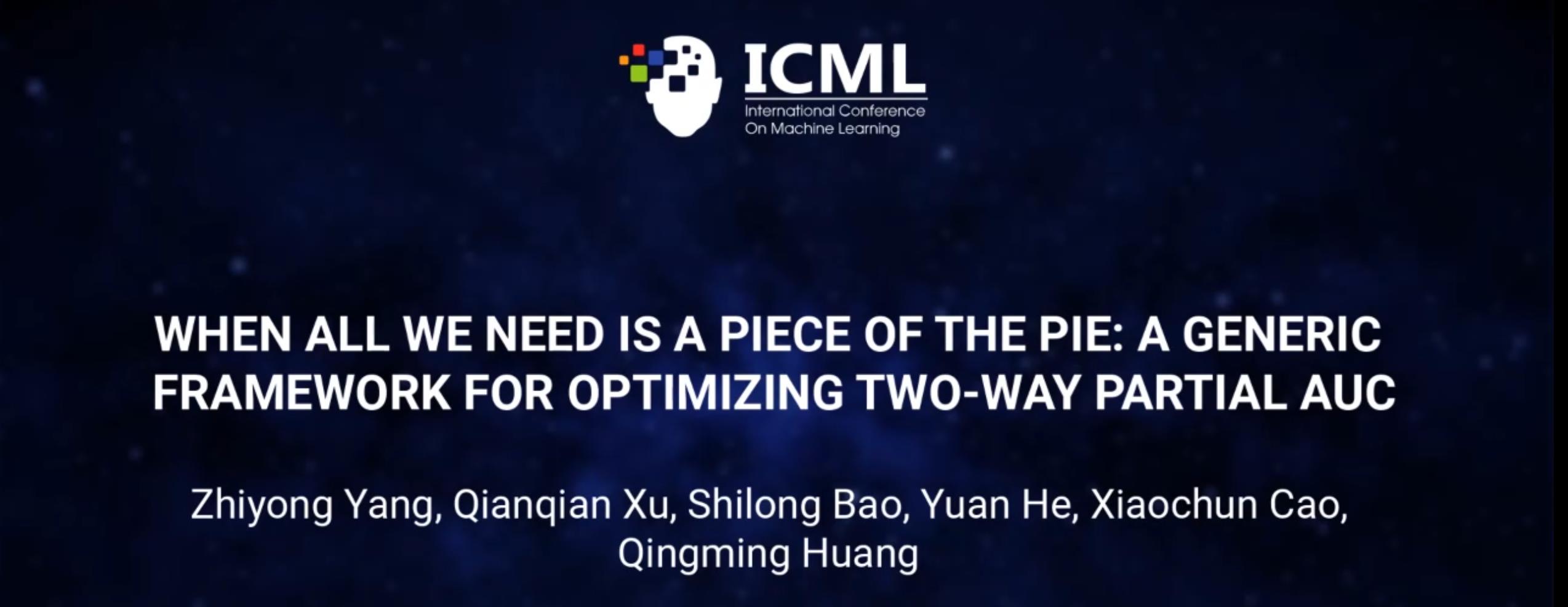
The Area Under the ROC Curve (AUC) is a crucial metric for machine learning, which evaluates the average performance over all possible True Positive Rates (TPRs) and False Positive Rates (FPRs). Based on the knowledge that a skillful classifier should simultaneously embrace a high TPR and a low FPR, we turn to study a more general variant called Two-way Partial AUC (TPAUC), where only the region with TPR ≥ α, FPR ≤ β is included in the area. Moreover, a recent work shows that the TPAUC is essentially inconsistent with the existing Partial AUC metrics where only the FPR range is restricted, opening a new problem to seek solutions to leverage high TPAUC. Motivated by this, we present the first trial in this paper to optimize this new metric. The critical challenge along this course lies in the difficulty of performing gradient-based optimization with end-to-end stochastic training, even with a proper choice of surrogate loss. To address this issue, we propose a generic framework to construct surrogate optimization problems, which supports efficient end-to-end training with deep-learning. Moreover, our theoretical analyses show that: 1) the objective function of the surrogate problems will achieve an upper bound of the original problem under mild conditions, and 2) optimizing the surrogate problems leads to good generalization performance in terms of TPAUC with a high probability. Finally, empirical studies over several benchmark datasets speak to the efficacy of our framework.
- Zhiyong Yang, Qianqian Xu, Shilong Bao, Yuan He, Xiaochun Cao and Qingming Huang. When All We Need is a Piece of the Pie: A Generic Framework for Optimizing Two-way Partial AUC. International Conference on Machine Learning (ICML), 11820–11829, 2021
- NeurIPS
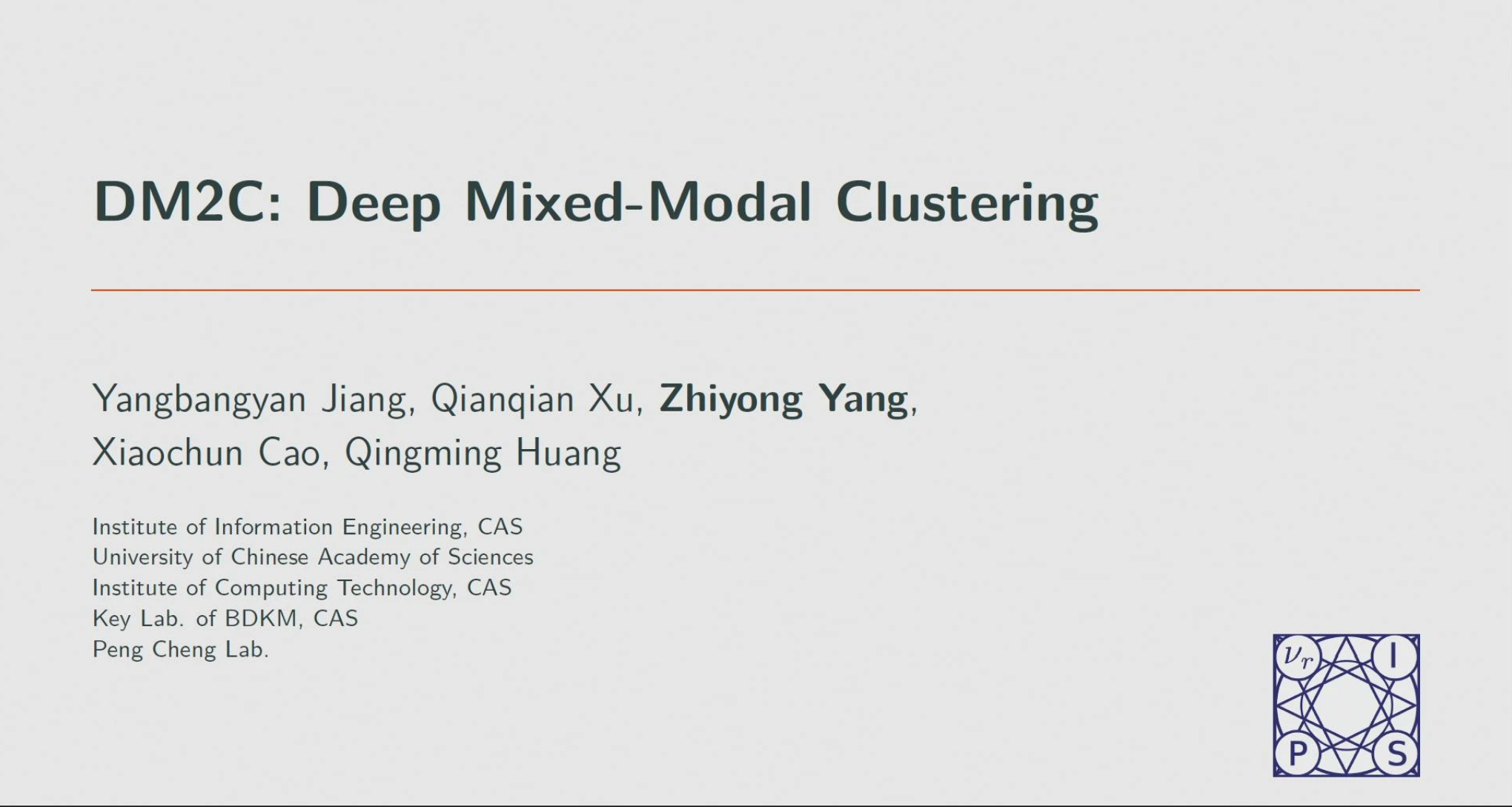
Data exhibited with multiple modalities are ubiquitous in real-world clustering tasks. Most existing methods, however, pose a strong assumption that the pairing information for modalities is available for all instances. In this paper, we consider a more challenging task where each instance is represented in only one modality, which we call mixed-modal data. Without any extra pairing supervision across modalities, it is difficult to find a universal semantic space for all of them. To tackle this problem, we present an adversarial learning framework for clustering with mixed-modal data. Instead of transforming all the samples into a joint modalityindependent space, our framework learns the mappings across individual modality spaces by virtue of cycle-consistency. Through these mappings, we could easily unify all the samples into a single modality space and perform the clustering. Evaluations on several real-world mixed-modal datasets could demonstrate the superiority of our proposed framework.
- Jiang, Yangbangyan, et al. Dm2c: Deep mixed-modal clustering. Advances in Neural Information Processing Systems 32 (2019).
